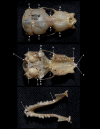Diversification and reproductive isolation: cryptic species in the only New World high-duty cycle bat, Pteronotus parnellii
- PMID: 23360354
- PMCID: PMC3567945
- DOI: 10.1186/1471-2148-13-26
Diversification and reproductive isolation: cryptic species in the only New World high-duty cycle bat, Pteronotus parnellii
Abstract
Background: Molecular techniques are increasingly employed to recognize the presence of cryptic species, even among commonly observed taxa. Previous studies have demonstrated that bats using high-duty cycle echolocation may be more likely to speciate quickly. Pteronotus parnellii is a widespread Neotropical bat and the only New World species to use high-duty cycle echolocation, a trait otherwise restricted to Old World taxa. Here we analyze morphological and acoustic variation and genetic divergence at the mitochondrial COI gene, the 7th intron region of the y-linked Dby gene and the nuclear recombination-activating gene 2, and provide extensive evidence that P. parnellii is actually a cryptic species complex.
Results: Central American populations form a single species while three additional species exist in northern South America: one in Venezuela, Trinidad and western Guyana and two occupying sympatric ranges in Guyana and Suriname. Reproductive isolation appears nearly complete (only one potential hybrid individual found). The complex likely arose within the last ~6 million years with all taxa diverging quickly within the last ~1-2 million years, following a pattern consistent with the geological history of Central and northern South America. Significant variation in cranial measures and forearm length exists between three of the four groups, although no individual morphological character can discriminate these in the field. Acoustic analysis reveals small differences (5-10 kHz) in echolocation calls between allopatric cryptic taxa that are unlikely to provide access to different prey resources but are consistent with divergence by drift in allopatric species or through selection for social recognition.
Conclusions: This unique approach, considering morphological, acoustic and multi-locus genetic information inherited maternally, paternally and bi-parentally, provides strong support to conclusions about the cessation of gene flow and degree of reproductive isolation of these cryptic species.
Figures







Similar articles
-
Coexistence of two sympatric cryptic bat species in French Guiana: insights from genetic, acoustic and ecological data.BMC Evol Biol. 2018 Nov 20;18(1):175. doi: 10.1186/s12862-018-1289-8. BMC Evol Biol. 2018. PMID: 30458712 Free PMC article.
-
Cryptic species? Patterns of maternal and paternal gene flow in eight neotropical bats.PLoS One. 2011;6(7):e21460. doi: 10.1371/journal.pone.0021460. Epub 2011 Jul 26. PLoS One. 2011. PMID: 21814545 Free PMC article.
-
Molecular phylogeny of hipposiderid bats from Southeast Asia and evidence of cryptic diversity.Mol Phylogenet Evol. 2012 Feb;62(2):597-611. doi: 10.1016/j.ympev.2011.10.021. Epub 2011 Nov 7. Mol Phylogenet Evol. 2012. PMID: 22079552
-
Patterns and causes of geographic variation in bat echolocation pulses.Integr Zool. 2015 May;10(3):241-56. doi: 10.1111/1749-4877.12129. Integr Zool. 2015. PMID: 25664901 Review.
-
Systematic review of Myotis (Chiroptera, Vespertilionidae) from Chile based on molecular, morphological, and bioacoustic data.Zootaxa. 2022 Sep 21;5188(5):430-452. doi: 10.11646/zootaxa.5188.5.2. Zootaxa. 2022. PMID: 37044767
Cited by
-
Systematics and phylogeography of bats of the genus Rhynchonycteris (Chiroptera: Emballonuridae): Integrating molecular phylogenetics, ecological niche modeling and morphometric data.PLoS One. 2023 May 4;18(5):e0285271. doi: 10.1371/journal.pone.0285271. eCollection 2023. PLoS One. 2023. PMID: 37141273 Free PMC article.
-
Wing morphology predicts individual niche specialization in Pteronotus mesoamericanus (Mammalia: Chiroptera).PLoS One. 2020 May 11;15(5):e0232601. doi: 10.1371/journal.pone.0232601. eCollection 2020. PLoS One. 2020. PMID: 32392221 Free PMC article.
-
Sensory trait variation in an echolocating bat suggests roles for both selection and plasticity.BMC Evol Biol. 2014 Mar 27;14(1):60. doi: 10.1186/1471-2148-14-60. BMC Evol Biol. 2014. PMID: 24674227 Free PMC article.
-
Coexistence of two sympatric cryptic bat species in French Guiana: insights from genetic, acoustic and ecological data.BMC Evol Biol. 2018 Nov 20;18(1):175. doi: 10.1186/s12862-018-1289-8. BMC Evol Biol. 2018. PMID: 30458712 Free PMC article.
-
A coalescent-based estimator of genetic drift, and acoustic divergence in the Pteronotus parnellii species complex.Heredity (Edinb). 2019 Apr;122(4):417-427. doi: 10.1038/s41437-018-0129-3. Epub 2018 Aug 17. Heredity (Edinb). 2019. PMID: 30120366 Free PMC article.
References
-
- Stehli FG, Webb SD. In: The Great American Biotic Interchange. Stehli FG, Webb SD, editor. New York: Plenum Press; 1985. A kaleidoscope of plates, faunal and floral dispersals, and sea level changes; pp. 3–15.
-
- Gregory-Wodzicki KM. Uplift history of the Central and Northern Andes: A review. Geol Soc Am Bull. 2000;112:1091–1105.
-
- Sutherland GD, Harestad AS, Price K, Lertzman KP. Scaling of Natal Dispersal Distances in Terrestrial Birds and Mammals. Conserv Ecol. 2000;4:16.
-
- Munguía M, Peterson AT, Sánches-Cordero V. Dispersal limitation and geographical distributions of mammal species. J Biogeogr. 2008;35:1879–1887.
-
- Cruzan MB, Templeton AR. Paleoecology and coalescence: phylogeographic analysis of hypotheses from the fossil record. Trends Ecol Evol. 2000;15:491–496. - PubMed
Publication types
MeSH terms
Substances
LinkOut - more resources
Full Text Sources
Other Literature Sources

